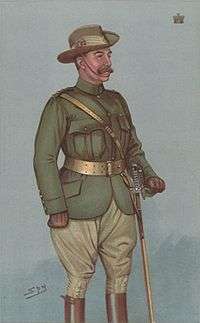Charles Cavendish, 3rd Baron Chesham
| The Right Honourable The Lord Chesham KCB, PC, DL | |
|---|---|
|
| |
| Master of the Buckhounds | |
|
In office 1 November 1900 – 1901 | |
| Monarch | Victoria |
| Prime Minister | The Marquess of Salisbury |
| Preceded by | The Earl of Coventry |
| Succeeded by | Office abolished |
| Personal details | |
| Born | 13 December 1850 |
| Died | 9 November 1907 (aged 56) |
| Nationality | British |
| Political party | Conservative |
| Spouse(s) | Lady Beatrice Constance Grosvenor |
Charles Compton William Cavendish, 3rd Baron Chesham KCB, PC, DL (13 December 1850 – 9 November 1907), styled The Honourable Charles Cavendish between 1863 and 1882, was a British soldier, courtier and Conservative politician. He served as the last Master of the Buckhounds under Lord Salisbury from 1900 to 1901.
Background
A member of the Cavendish family headed by the Duke of Devonshire, Chesham was the eldest son of William Cavendish, 2nd Baron Chesham and his wife Henrietta Frances Lascelles, daughter of William Lascelles.
Political career
Lord Chesham took his seat in the House of Lords on his father's death in 1882.
In November 1900 he was appointed Master of the Buckhounds under Lord Salisbury. However, as Chesham was serving in South Africa, Lord Churchill was appointed to act as Master of the Buckhounds in his absence.[1] Chesham remained Master until the office was abolished the following year. He was admitted to the Privy Council in July 1901,[2] and also served as a Lord of the Bedchamber to the Prince of Wales (later King George V) from 1901[3] to 1907.
Military career
Chesham held an appointment as Lieutenant colonel of the Royal Buckinghamshire Hussars Yeomanry from 1889. In January 1900 he was appointed in command of the 10th battalion of the Imperial Yeomanry (which included companies from Buckinghamshire, Berkshire and Oxfordshire), serving in the Second Boer War,[4] and received the temporary rank of Colonel in the Army.[5] He left Southampton on board the SS Norman in early February 1900,[6] and arrived in South Africa the following month. Later that year, he was promoted to Brigadier general and in November 1900 appointed a Knight Commander of the Order of the Bath (KCB) for his services[7] (he was invested by King Edward VII at Marlborough House 25 July 1901 during a brief visit to London). From 1901 he was Inspector general of Imperial Yeomanry in South Africa, with the local rank of Major-general. He relinquished his commission and was granted the honorary rank of Major-General in the Army on 22 January 1902,[8] leaving South Africa the following month by the steamer RMS Kinfauns Castle.[9] After his return to the United Kingdom, he was in late April 1902 appointed Inspector General of Imperial Yeomanry (at Army Headquarters) with the temporary rank of Major-General whilst so employed.[10]
Lord Chesham was appointed to the honorary colonelcy of the Buckinghamshire Imperial Yeomanry (Royal Bucks Hussars) on 19 March 1902.[11]
Family
Lord Chesham married, in 1877, his second cousin Lady Beatrice Constance Grosvenor (1858-1911), daughter of Hugh Grosvenor, 1st Duke of Westminster. They had two sons and two daughters:
- Lieutenant the Honourable Charles William Hugh Cavendish (1878-1900), 2nd Lieutenant in the 17th Lancers, killed in South Africa during the Second Boer War
- Honourable Lilah Constance Cavendish (1884-1944), married 1903 Sir Mervyn Manningham-Buller, 3rd Baronet (1876-1956)
- Honourable Marjorie Beatrice Cavendish (1888-1897)
- John Compton Cavendish, 4th Baron Chesham (1894-1952)
Lady Chesham was appointed a Lady of Grace of the Order of St. John (DStJ) in July 1901,[12] and in December the same year received the decoration of the Royal Red Cross (RRC) for her services with the Imperial Yeomanry Hospital during the Boer War.[13]
Lord Chesham died in November 1907, aged 56, after a hunting accident. There is a bronze statue commemorating his life and deeds located in the Market Square in Aylesbury, Buckinghamshire which has Grade II Listed Building status.[14] He was succeeded in the barony by his second but eldest surviving son John.
References
- ↑ The London Gazette: no. 27243. p. 6689. 2 November 1900.
- ↑ The London Gazette: no. 27338. p. 4919. 26 July 1901.
- ↑ The London Gazette: no. 27378. p. 7472. 19 November 1901.
- ↑ The London Gazette: no. 27155. p. 362. 19 January 1900.
- ↑ The London Gazette: no. 27156. p. 428. 23 January 1900.
- ↑ "The War - Embarcation of Troops". The Times (36063). London. 12 February 1900. p. 10.
- ↑ The London Gazette: no. 27306. p. 2696. 19 April 1901.
- ↑ The London Gazette: no. 27427. p. 2689. 22 April 1902.
- ↑ "The War - movements of troops". The Times (36672). London. 23 January 1902. p. 8.
- ↑ The London Gazette: no. 27428. p. 2794. 25 April 1902.
- ↑ The London Gazette: no. 27417. p. 1887. 18 March 1902.
- ↑ The London Gazette: no. 27330. p. 4469. 5 July 1901.
- ↑ "Court circular". The Times (36641). London. 18 December 1901. p. 6.
- ↑ Statue with Grade II Listed Building status. Heritage Gateway website, Retrieved 2009_10_19
External links
- Hansard 1803–2005: contributions in Parliament by Lord Chesham
| Political offices | ||
|---|---|---|
| Preceded by The Earl of Coventry |
Master of the Buckhounds 1900–1901 |
Office abolished |
| Peerage of the United Kingdom | ||
| Preceded by William George Cavendish |
Baron Chesham 1882–1907 |
Succeeded by John Compton Cavendish |
